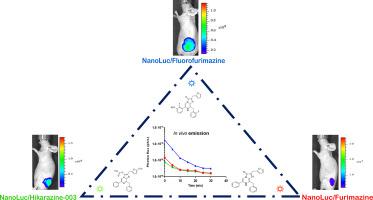Journal of Photochemistry and Photobiology B: Biology ( IF 3.9 ) Pub Date : 2021-01-26 , DOI: 10.1016/j.jphotobiol.2021.112128 Natasa Gaspar 1 , Joel R Walker 2 , Giorgia Zambito 3 , Kranthi Marella-Panth 4 , Clemens Lowik 5 , Thomas A Kirkland 2 , Laura Mezzanotte 4

|
NanoLuc luciferase recently gained popularity due to its small size and superior bioluminescence performance. For in vivo imaging applications, NanoLuc has been limited by its substrate furimazine, which has low solubility and bioavailability. Herein, we compared the performances of recently reported NanoLuc luciferase substrates for in vivo imaging in mice. Two substrates with improved aqueous solubility, hydrofurimazine and fluorofurimazine, were evaluated along with three stabilized O-acetylated furimazine analogues, the hikarazines. All 5 analogues, when tested in vitro, displayed greater signal intensity and reaction duration, in comparison to the standard NanoLuc substrate, furimazine. The two best-performing analogues from the in vitro study were selected for further in vivo testing. The NanoLuc/fluorofurimazine pair demonstrated the highest bioluminescence intensity, post intravenous administration. It was found to be around 9-fold brighter compared to the NanoLuc/furimazine and 11-fold more intense than the NanoLuc/hikarazine-003 pair, with an average of 3-fold higher light emission when the substrate was injected intraperitoneally, in a subcutaneous model. Excitingly, despite the fact that NanoLuc/fluorofurimazine emits mostly blue light, we prove that cells trapped in mice lungs vasculature could be visualised via the NanoLuc/fluorofurimazine pair and compare the results to the AkaLuc/AkaLumine system. Therefore, among the tested analogues, fluorofurimazine enables higher substrate loading and improved optical imaging sensitivity in small animals, upgrading the use of NanoLuc derived bioluminescent systems for deep tissue imaging.
中文翻译:

NanoLuc 底物对小鼠转移细胞生物发光成像的评估
NanoLuc 荧光素酶由于其小尺寸和优异的生物发光性能最近受到欢迎。对于体内成像应用,NanoLuc 受到其底物呋喃嗪的限制,其溶解度和生物利用度较低。在此,我们比较了最近报道的 NanoLuc 荧光素酶底物在小鼠体内成像的性能。评估了两种具有改善的水溶性的底物,氢呋喃嗪和氟呋喃嗪,以及三种稳定的O-乙酰化呋喃嗪类似物,hikarazine。与标准 NanoLuc 底物腔肠素类似物相比,所有 5 种类似物在体外测试时均显示出更高的信号强度和反应持续时间。体外研究中选择了两种表现最好的类似物进行进一步的体内测试。 NanoLuc/氟呋喃嗪对在静脉注射后表现出最高的生物发光强度。结果发现,与 NanoLuc/furimazine 相比,它的亮度大约是 NanoLuc/furimazine 的 9 倍,强度是 NanoLuc/hikarazine-003 对的 11 倍,当底物腹膜内注射时,其发光量平均高出 3 倍。皮下模型。令人兴奋的是,尽管 NanoLuc/氟呋喃嗪主要发射蓝光,但我们证明,可以通过NanoLuc/氟呋喃嗪对可视化捕获在小鼠肺血管系统中的细胞,并将结果与 AkaLuc/AkaLumine 系统进行比较。因此,在测试的类似物中,氟呋马嗪能够实现更高的底物负载并提高小动物的光学成像灵敏度,从而升级 NanoLuc 衍生的生物发光系统在深层组织成像中的使用。

































 京公网安备 11010802027423号
京公网安备 11010802027423号